Resilient Buildings that Bounce Back
Learning Objectives:
- Identify the various types of doors that can contribute to different aspects of resilience in buildings including floods, tornadoes, blasts, and bullets.
- Assess the importance of expansion joints as a key component in buildings to allow for movement from thermal, seismic, or wind forces.
- Recognize the importance of maintaining critical operations using a reliable on-site energy source.
- Determine ways to incorporate the principles presented in this course into buildings as shown in case studies.
Credits:
This course is approved as a Structured Course
This course can be self-reported to the AANB, as per their CE Guidelines
Approved for structured learning
Approved for Core Learning
This course can be self-reported to the NLAA
Course may qualify for Learning Hours with NWTAA
Course eligible for OAA Learning Hours
This course is approved as a core course
This course can be self-reported for Learning Units to the Architectural Institute of British Columbia
Design and construction professionals have regular reminders that buildings can suffer serious damage or even be destroyed by weather and location-related events such as severe storms, intense heat, attacks, or earthquakes. Media and professional journals regularly describe the impacts of these events, but more significantly, an increasing number of design professionals experience them directly – either from personal experience or through project work. Many building owners, too, have experienced the impacts or the liability concerns associated with such events and the need to recover quickly from them to maintain operations. This growing awareness of the potential hazards and risks to both people and property has prompted the development of codes and standards upon which to base design decisions. This course focuses on some specific strategies that can be used to address the concerns of serious events, whether natural disasters or human-made. In particular, aspects of design are addressed related to withstanding such events so that buildings can be resilient enough to bounce back into safe operation. These aspects are reviewed from the standpoint of some common vulnerabilities in buildings, namely, exterior doors, expansion joints, and operational energy sources.

Photo courtesy of AMBICO
Resilience is the ability of a building to maintain or resume operations during or following a severe event, including climate-related natural disasters or human-made incidents.
RESILIENT DOORS
The design and construction of wall, roof, and floor assemblies that are strong enough to withstand severe conditions is a fairly straightforward process in terms of using substantial, reinforced materials (i.e., concrete, CMU, etc.) following available standards. However, any building will only be as strong as its weakest parts, which in many cases are the windows and doors in a facade. Operable doors, in particular, which people may be using to exit, or potentially shelter behind, need to protect those people appropriately. In fact, it is the whole door assembly (door, frame, and hardware) that must be designed to work together to provide the protection needed.
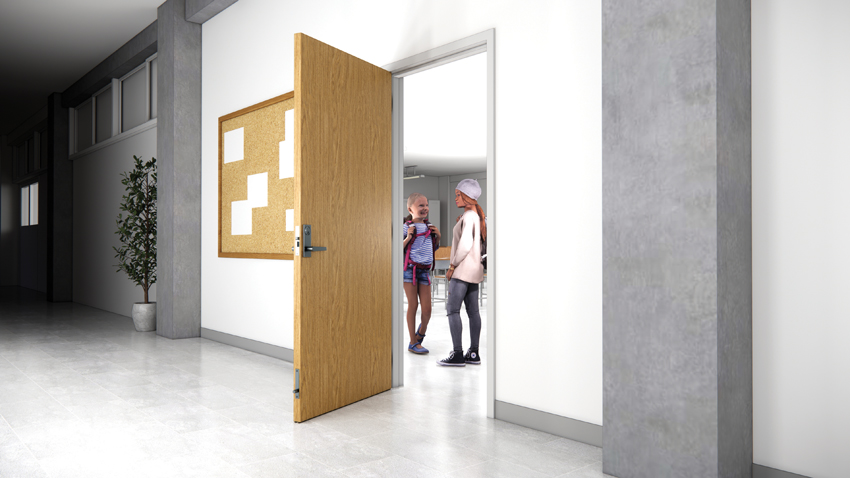
Photo courtesy of AMBICO
Tornado-resistant and flood-resistant doors are increasingly sought out to protect against severe weather and are available in steel (both door types) or wood (tornado-resistant only) finishes.
To illustrate, we look at exterior doors from the standpoint of resilience in four different categories as follows:
Tornado Resistance
Resistance to both high winds and airborne debris, or “missiles,” blown through the air has been shown to be critical in resisting tornadoes or hurricanes. States within areas that are prone to these weather events have adopted standards requiring demonstrated protection as part of their localized building codes. This is predicated on the fact that, in the United States, tornadoes are the most destructive windstorm and are responsible for the greatest number of wind-related deaths annually. Further, insurance claim losses from a single tornadic event of $1 billion or more are becoming more frequent.
There are two recognized national standards for tornado-resistant doors that are part of larger standards for storm shelters and safe rooms. The first is ICC 500: ICC/NSSA Standard for the Design and Construction of Storm Shelters published jointly by the International Code Council (ICC) and the National Storm Shelter Association (NSSA). This standard is referenced in the newest building safety codes and provides minimum design and construction requirements for shelters that provide a safe refuge from storms that produce high winds, hurricanes, and tornadoes. The second is FEMA P-361, “Safe Rooms for Tornadoes and Hurricanes: Guidance for Community and Residential Safe Rooms.” This standard, supported by the U.S. Department of Homeland Security, addresses many of the same things that ICC-500 does, but is more stringent in some cases.
When specifying tornado-resistant door assemblies, the first thing to consider is a single source manufacturer with a complete package solution including the frame, door(s), and hardware. This helps with quality control and the coordination of all elements working together toward the desired end of total safety, meeting or exceeding the FEMA P-361 and ICC-500 requirements. Installation of the door assembly in the field is another important step in having a tornado-resistant door become part of a safe building. Some manufacturers offer certified installation courses to contractors because they recognize that the field installation is critical to life safety. With such a certification course, architects and owners can have some peace of mind that once installed in the field, the door assembly performs the same way it does in the testing lab.
Flood-Resistant Doors
Flooding in the United States has increased in frequency and intensity in the last 20 years whether as part of a larger storm or a stand-alone, localized event. As a result, there is a growing demand in more locations than ever for proactive solutions that can help keep flood water from entering a building through a door assembly. That usually means specifying a coordinated system of a door, frame, perimeter seals, door bottom, and threshold that can work together to withstand hydrostatic pressure and minimize water leakage.
The process of making a flood-resistant door involves attention to several details. The first is a robust system of water seals around the entire perimeter of the door. While it is common to have such seals for protecting against drafts and the general weather, water seals are usually more sophisticated and tested for the ability to resist standing water. Common solutions to help with positive sealing include the use of exterior outswing doors where standing water pushing against the door panel helps to seat the door into the frame. There are also solutions available for unseated applications which can be evaluated for their applicability in certain projects. In applications where doors are seated into the frame, standard builder’s hardware can typically be used. Where doors are unseated, special hinges and latching hardware is more often supplied by the door manufacturer.
Details of the assemblies in terms of material and make-up are also important. Galvanized steel or stainless steel are the common materials of choice which offer strength, durability, and extended life in corrosive environments. Frame options include four-sided frames, which include the threshold side in addition to the usual head and jambs. Where needed, ADA-compliant bumper or saddle thresholds are available, too. In order to ensure the integrity of the frame connection to the surrounding structure, standard or customized anchor solutions can be specified to address flood resistance. Custom engineered solutions are also available to add debris impact resistance to the door assemblies based on project-specific requirements.
Blast-Resistant Doors
Resilience also includes the need to withstand blasts or explosions, whether accidentally caused by operations, triggered by utility disruptions from severe weather, or intentionally caused by acts of terrorism. Federal government buildings around the world are required to include this aspect of resilience and safety in virtually all their exterior doors based on Unified Facility Criteria UFC 4-010-01 “DoD Minimum Antiterrorism Standards for Buildings.” This standard makes it clear that unless a door failure in response to an applied blast load does not pose a risk to occupants (i.e., the door is intercepted by a suitably strong wall before entering an occupied area) all doors must be evaluated for blast resistance at the applicable charge weights and standoff distances.
When seeking to evaluate doors for blast resistance there are two relevant standards. The first is ASTM F2927 “Standard Test Method for Door Systems Subject to Airblast Loadings.” This is a laboratory test that requires a specialized testing chamber that uses pressurized air to create the testing blast. The second standard is ASTM F2247 “Standard Test Method for Metal Doors Used in Blast Resistant Applications (Equivalent Static Load Method).” This test can be combined with finite element analysis and software to verify blast door and frame performance for virtually any charge weight, standoff, and level of protection scenario.
Door manufacturers increasingly offer blast-resistant door systems as part of their resilient design portfolio. Products are commonly engineered to meet the needed blast requirements while keeping the weight of the operable doors and frames as low as possible.
Bullet-Resistant Doors
In the United States, the threat of an active shooter situation has become a significant concern for many building types. This can be a risk in severe events as well as normal daily operations. Hence, there is often a need for bullet-resistant solutions to protect against this risk. Bullet-resistant doors and frames can be used for protection against a wide range of hand, rifle, and military attack weapons. They are available in steel doors and frames that are able to operate using conventional builder’s hardware. They are also readily available with a range of wood veneers.
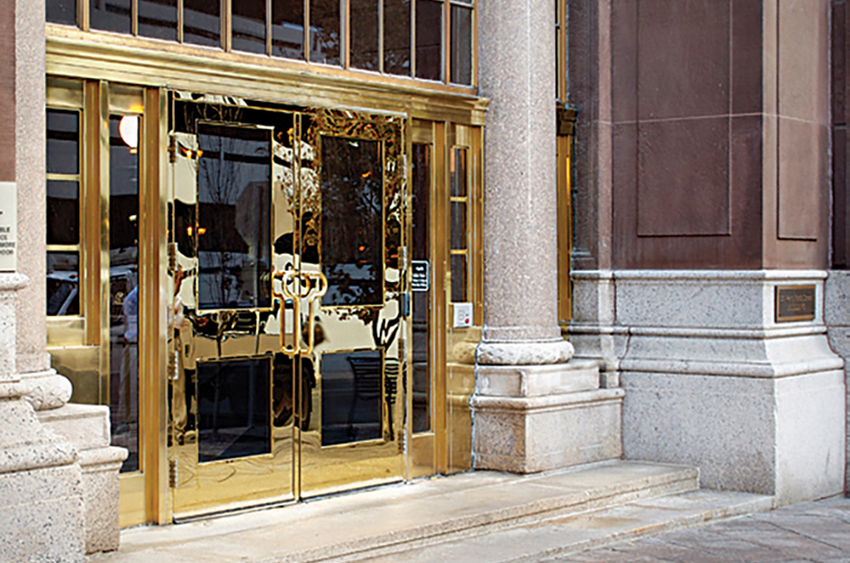
Photo courtesy of AMBICO
Performance-tested, blast and bullet-resistant door assemblies are available in a range of sizes and material finishes, with options for factory or field-installed hardware. Shown here is a bullet-resistant opening meeting UL-752 level 3 performance, clad in colored, mirror-finish stainless steel, giving an ornate appearance to the building's main entrance.
Notice
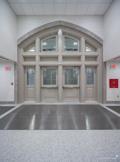
www.ambico.com
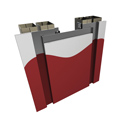
www.inprocorp.com
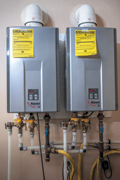
www.propane.com















